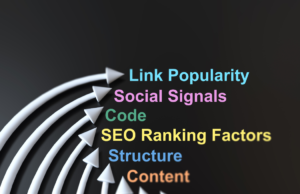If you’ve ever wondered how websites rank on Google, you’re not alone. With millions of search queries made daily, businesses and content creators compete for those top spots. But what exactly influences these rankings?
Search Engine Optimization (SEO) isn’t just about stuffing keywords—it’s about creating high-quality content that search engines and users love. In this guide, we’ll break down the most important SEO ranking factors that determine how well your site performs in search results.
By the end, you’ll have a clear understanding of what matters most in SEO and how you can leverage these factors to boost your rankings. Let’s dive in!

1. High-Quality Content
Content remains the king of SEO. Google prioritizes valuable, relevant, and well-structured content that satisfies search intent. Here’s what defines high-quality content:
- Relevance – Your content should align with what users are searching for.
- Originality – Avoid duplicate or thin content. Unique, engaging content wins.
- Depth & Detail – Answer users’ questions thoroughly.
- Readability – Use short sentences, bullet points, and subheadings for easy scanning.
- Multimedia – Images, videos, and infographics enhance engagement.
Pro Tip: Use tools like Google’s People Also Ask section to find related queries and expand on them in your content.
2. Search Intent Optimization
Understanding search intent is crucial. Users type queries with different intentions:
- Informational – Looking for knowledge (e.g., “How does SEO work?”)
- Navigational – Searching for a specific website (e.g., “Facebook login”)
- Transactional – Ready to make a purchase (e.g., “Buy running shoes online”)
Align your content with search intent to improve engagement and reduce bounce rates.
3. Keyword Optimization (But No Keyword Stuffing!)
Keywords help Google understand your content, but overusing them can hurt rankings. Use:
- Primary keyword in the title, first 100 words, and headings.
- LSI (Latent Semantic Indexing) keywords – Related terms that add context.
- Long-tail keywords – Less competitive phrases with higher conversion potential.
Example: Instead of just targeting “SEO tips,” use “best SEO tips for beginners.”
4. Page Experience & Core Web Vitals
Google’s Core Web Vitals measure user experience based on:
- Loading Speed – Faster pages rank better.
- Interactivity – Ensure quick responses to user actions.
- Visual Stability – Avoid layout shifts that frustrate users.
Use tools like Google PageSpeed Insights to optimize performance.
5. Mobile-Friendliness
With over 60% of searches happening on mobile, a responsive design is non-negotiable. Google’s mobile-first indexing means it primarily evaluates your mobile version.
Quick Fixes:
- Use responsive design.
- Ensure fast-loading of mobile pages.
- Make navigation touch-friendly.
6. Backlinks (Authority & Trust)
High-quality backlinks from reputable sites signal authority. But not all links are equal:
- Do-follow vs. No-follow: Do-follow links pass SEO value.
- Relevance matters: Links from related industries carry more weight.
- Anchor text optimization: Descriptive anchor texts improve credibility.
Pro Tip: Focus on white-hat link-building strategies like guest posting and digital PR.
7. On-Page SEO (Titles, Meta, URLs)
Well-optimized on-page elements improve click-through rates (CTR):
- Title Tags – Keep them under 60 characters with keywords.
- Meta Descriptions – Persuasive, 150-160 characters long.
- URL Structure – Short, descriptive, and keyword-rich.
Example:
Bad URL: www.example.com/p=123 Good URL: www.example.com/seo-ranking-factors
8. User Engagement Metrics (Dwell Time, CTR, Bounce Rate)
Google tracks how users interact with your site:
- Dwell Time: How long visitors stay on a page.
- CTR (Click-Through Rate): Higher CTR signals relevance.
- Bounce Rate: If users leave too quickly, it’s a red flag.
Quick Boost:
- Write compelling meta descriptions to increase CTR.
- Use engaging introductions to reduce bounce rates.
9. Internal Linking & Site Structure
Internal links help search engines understand site hierarchy and improve navigation.
- Use descriptive anchor texts.
- Link to relevant pages to keep users engaged.
- Avoid orphan pages (pages with no internal links pointing to them).
Example: Link from a blog post on SEO tips to your SEO services page.
10. Technical SEO (Schema, Sitemaps, HTTPS)
Technical SEO ensures search engines can crawl and index your site effectively:
- SSL Certificate (HTTPS) – A secure site boosts trust and rankings.
- Schema Markup – Helps Google understand your content better.
- XML Sitemap – Ensures search engines find all pages.
- Robots.txt – Controls which pages should or shouldn’t be crawled.
11. Social Signals & Brand Authority
While social media doesn’t directly impact rankings, it boosts visibility and engagement.
- Shareability: Make content easy to share.
- Brand mentions: More mentions = more authority.
- Consistent NAP (Name, Address, Phone) for Local SEO.
12. Local SEO (Google My Business & Citations)
For businesses targeting local customers, optimize for local search:
- Google My Business (GMB) Optimization – Keep your listing updated.
- Citations & Reviews – Consistent details across directories.
- Local Keywords – Include location-based terms.
Example: Instead of just “best coffee shop,” use “best coffee shop in New York.”
Final Thoughts
SEO is constantly evolving, but these ranking factors remain critical. Prioritize high-quality content, technical SEO, backlinks, and user experience to stay ahead.
Want to improve your rankings? Start by applying these strategies today!
What SEO factor do you find most challenging? Let us know in the comments!










